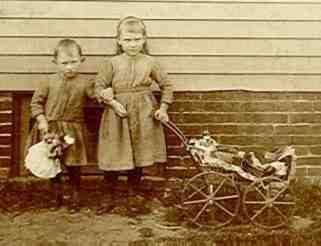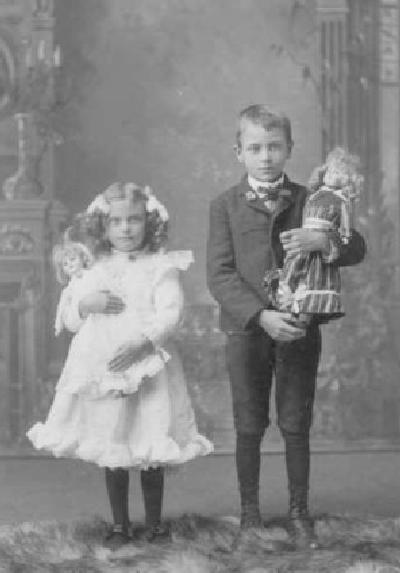
Interpreting Images of 19th Century Children: Toys and Props--Dolls

Figure 1.--While dolls are usually a good indicator the child is a girl,
boys with older sisters are an exception. Also notice how the child is holding the doll. Note that this is an informal family snapshot. Formal studio portraits of boys with dolls are much less common.
|
A child holding a doll is probably a girl. There are, however, photographs of boys playing with dolls. Even so, dolls are strong indicators that the child is a girl. One major exception to the doll indicator is boys with older sisters. Not only was he
likely to wear his older sisters hand-me-downs, but he was more likely to be interested in
doing the things like playing dolls that his older sister does. And he was less likely
to be upset about wearing dresses. We believe that unlike some other props, it was the child that would usually choose the toy, including dolls, with which he or here was photgraphed. Other factors that need to be considered are chronological and country differences. After the turn of the 20th century it became even less common for boys to be photographed will dolls. Part of the reason for this was the appearance of the teddy bear. The teddy bear became an almopst overnight success when it appeared in America in 1902, later in other countries. Boys who might once have been photographed will dolls, were then almost always photographed with their teddies. Another factor is country differences. A French reader reports, "I must add in France that little boys pften played with cloth-doll. After 1930, the mothers preferd to replace the doll with "nounours" (teddy bars)." Dolls since the1970s have made something of a recovery for boys, at least in America, but they are of course now called "action figures". In this regard they are called action fogures. Boys are not, however, commonly photographed playing with these dolls.
Gender Conventions
A child holding a doll is probably, but not always, a girl. There are, however, portraits of boys posing with dolls. Most commonly these are informal family snapshots of them playing with dolls. Many of these images were taken in the early 20th century after the aooearance of the Kodak Brownie in 1900. Actual formal 19th century portraits of boys with dolls are realtively rare. After World War I (1914-18), bboys photographed with dolls begin to become rarer as boys were increasingly given teddy bears rather than dolls. Thus while certain not an avsolute indicator, dolls are strong indicators that the child in question is a girl. This needs to be confirmed with other indicators such as dress, pose, appearance, hair style and other factors.
HBC has used dolls to help identify the gender of children in old photographs. Usually a doll meant that the child was a girl--especially in formal studio portraits. There were, however, some exceptions. HBC had assumed that most boys, even in the 19th century, would want no part of dolls. Subsequent reserach has discovered, however, that some boys did willingly play with dolls. It appears that genderlines on dolls wre not as distinct as once believed. Few details are avialble but HBC believes that boys raised with older sisters would be more likely to play with dolls, especially if they were schooled at home. Some mothers might even have incouraged it. Similarly girls raised with boys would be more likely to play with boys' toys and take an interest in sport. Also boys in orphanages might play with dolls as the orphanages sometimes accepted donations and the boys might have few other options if dolls were donated.
Doll Gender
An important factor in assessing the gender of a child with a doll is the doll gender. We believe that girls generally preferred girl dolls. This is the case today and we see no reason why it would be different today. A modern girl may have both a Ken and Barbie doll, but invairiably she would have received the Barbie before the Ken and in most cases has several Barbies in addition to Ken. Thbis is the case because some of the major activities girls pursue with dolls is dressing them and with more exensive dolls, doing their hair. We also believe that many if not most boys with dolls had boy dolls. Boys tend to play with dolls differently. They are less interested in dressing them than in using them for imaginined adventure activities, for which boy dolls would have been more suitable.

Figure 2.--This boy has a doll just like his little sister. He looks to be about 6-7 years old which is old enough to have begun school. We wonder if he was being schooled at home. We have not noted older boys playing with dolls.
|
One major exception to the doll indicator is boys with sisters--especially but not always older sisters. Not only was he
likely to wear his older sisters hand-me-downs, but he was more likely to be interested in doing the things like playing dolls that his older sister does. And he was less likely to be upset about wearing dresses. This is particularly important as younger children tend to copy the things they see adults and older siblings do. In this regard younger pre-school children are not as affected by established gender conventions as they are after they begin school. Even with sisters, boys do not normally play will dolls much beyond the age of beginning school.
Institution
Another exception may be an institution like an orphanage where toys were rare and the child had to pklay with whatever was available. Or in other instances, toys and dolls may have been donated as gifts and the child had to accept what was offered. Of course these children were less likely to have individual portraits taken.
Selection
We believe that unlike some other props, it was the child that would usually choose the toy, including dolls, with which he or here was photographed. We know that 19th century children were less questioning, certainlty about clothes. There are, however, certain inate behavir patterns. A young child to be photographed might feel more comfortable with a favored play thing. A slightly older child might have a ceratin pride of ownership. Parents were probably willing to tolerate this to a degree they would not accept any clothing preferences a child might express.
Chronological Trends
After the turn of the 20th century it became even less common for boys to be photographed will dolls. We are not sure just why this was. Surely ione factor was the appearance of teddy bears, but we believe other factiors were involved.
Part of the reason that boys began playing less with dolls was the appearance of the teddy bear. The teddy bear became an almost overnight success when it appeared in America in 1902, later in other countries. Boys who might once have been photographed will dolls, were then almost always photographed with their teddies. Girls also came to enjoy teddy bears and we have not yet fully assessed the gender conventions involved here.
Country Differences
Another factor is country differences. Many of the images of bots with dolls that we have found arfe American boys, but this is presumably a function of our greater access to American images. Country variations is a topic that we have not yet been able to address in any detail. A French reader reports, "I must add in France that little boys pften played with cloth-doll. After 1930, the mothers prefered to replace the doll with "nounours" (teddy bars)." We note an unidentified German boy about 1900-05 with a collection of dolls, azlthough they may be studio dolls.
Modern Dolls for Boy
Dolls since the 1970s have made something of a recovery for boys, at least in America, but they are of course now called "action figures". There is a certain aversion among many parents with their sons playing with dolls. The toy companies realized that to sell dolls to boys that they would have to be renamed. In this regard they are called action figures. Boys are not, however, commonly photographed playing with these dolls. One exception was TV's Eddie Minster and Wolfie, although I do not recall him playing with Wolfie in any of the episodes.
Specific Examples
We will cross reference here some examples that we have noted of children posing with dolls for their photographs. While we have listed several such pages, there are quite a few more that we have not yet managed to find so that they can be listed.
This undated image was taken in Berlin, probably in the 1900s, certainly before World War I. At first examination it looks like a girl, indicating that German girls also wore tunics. HBC is not, however, positive that it is a girl. The tunic is quite long and has a double row of vuttons. The pants do not show as was the normal convention. There is a large square white collar trimmed in lace and and repeated at the wrist cuffs. The collar is worn with a small bow. The outfit is worn with heavy long stockings. The child is photographed with a favorite doll.
Here we will assess the doll as a toy and not just as a photographic prop.
From all appearances the younger child here looks like a girl. The long hair and barette certainly look like a girl. Some mothers in the early 20th century still dressed their younger boys in dresses and long hair, although by 1910 it was becoming less common than in the 19th century. The one factor that suggests this child may be a boy is that the doll is a boy doll. Most girls, of course, prefer girl dolls.
The main HBC toy page has a photohraph of Emil Zola's son and hs dolls. He looks to be 6-7 years old.
When I was a child many years ago, my parents used to drop me off at my grandmotherís house on weekends when they needed a break from parenting. Grandmother (or "Bama" as I called her) lived in a turn-of-the-century Victorian home with lots of history in it and many rooms to explore. On one occasion, I came across a box of old photographs stashed away somewhere which showed my grandmother and grandfather along with other old photo and Daguerreotypes of the family. In the collection, I saw some pictures of a very pretty young girl whom I had never heard my family talking about. I took the box down to Bama and showed her the pictures. "Lawd," she said, "those are pictures of your grandfather. You see, back in those days most little boys and girls were dressed the same way until school. It was just the fashion. One of the images showed grandfather with a doll.
One question which has to be asked in assessing these doll and toy images is who they belonged to. An English reader writes, "I have numerous other photos of boys with toys and some with a puppet or marionette beside them. The question is whether these toys actually belonged to the boys or whether they were just props lying around the photogrpahers
studio. My guess is that most of the time they are studio props. On the other hand, when a girl is photographed with her doll I would assume the girl actually owns the doll she is pictured with."
HBC

Navigate the Boys' Historical Clothing Web Site:
[Return to:Main photo prop page]
[Return to:Main photo interpretation page]
[Introduction]
[Activities]
[Biographies]
[Chronology]
[Countries]
[Clothing styles]
[Bibliographies]
[Contributions]
[FAQs]
[Glosssaries]
[Tools]
[Boys' Clothing Home]
Navigate the Boys' Historical Clothing Web Site:
[Sailor suits]
[Sailor hats]
[Buster Brown suits]
[Eton suits]
[Rompers]
[Tunics]
[Smocks]
[Pinafores]
Created: April 13, 2002
Last updated: 2:45 AM 1/21/2006




